Xuefei Chen Axelsson
STOCKHOLM, Sept.5(Greenpost)–Swedish Princess Victoria spoke at 2016 World Water Week.
https://siwi-mediahub.creo.se/world-water-week/2016-water-for-sustainable-growth/crown_princess_victoria_speech_at_world_water_week_2016
Xuefei Chen Axelsson
STOCKHOLM, Sept.5(Greenpost)–Swedish Princess Victoria spoke at 2016 World Water Week.
https://siwi-mediahub.creo.se/world-water-week/2016-water-for-sustainable-growth/crown_princess_victoria_speech_at_world_water_week_2016
By Xuefei Chen Axelsson
Stockholm, Sept. 5(Greenpost)-As a home design company in Sweden, DayMe Home AB are participating in Maison Object in Paris for the first time and its environmentally friendly home products are welcomed by many dealers at the ongoing exhibition.
 DayMe Home AB pays great attention to Chinese market development and cooperation. Last year, its CEO Jasper Zhang began to try to combine the Swedish design with Chinese traditional dyeing technology to realise mass production with modern technology and provide the public with many environmentally-friendly home products.
DayMe Home AB pays great attention to Chinese market development and cooperation. Last year, its CEO Jasper Zhang began to try to combine the Swedish design with Chinese traditional dyeing technology to realise mass production with modern technology and provide the public with many environmentally-friendly home products.
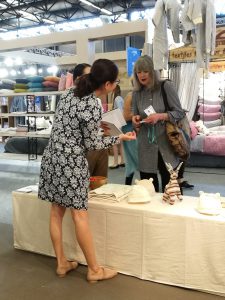 ”C’est tres jolie! C’est beau!” It’s really beautiful! Many French people exclaimed when they saw the children’s clothes and touched them gently.
”C’est tres jolie! C’est beau!” It’s really beautiful! Many French people exclaimed when they saw the children’s clothes and touched them gently.
The staff of DayMe felt very proud to tell the dealers that babies can ”eat” these clothes without any worries of chemicals.
During the exhibition, DayMe’s children and home products characterised by environmentally-friendly concept and fashion design attracted a lot of dealers from many countries including Danmark, France, Germany, Ireland, Italy, Japan, Latvia, Russia, South Korea, Spain and the United States.
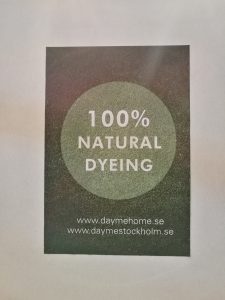 Janice Liang, Operation Manager of DayMe explained to Green Post in a written interview that the cotton used to make these clothes is 100 percent natural and organic from the field. It has won GOTS certificates.
Janice Liang, Operation Manager of DayMe explained to Green Post in a written interview that the cotton used to make these clothes is 100 percent natural and organic from the field. It has won GOTS certificates.
”The dyeing process uses natural plants-extracted dyeing material and even its additives are extracted from plants and minerals,” said Janice.
”Those who are familiar with textile industry call it an environmental technology revolution in textile industry. China’s traditional herbs Radix is an important component in dyeing material. Different colors are extracted from different plants, but almost all the dyeing materials use radix, thus it not only has no heavy metal, fragrances, formaldehyde or fluorescent agents, but also can somewhat resist bacteria,” said Janice.
”The virtue of our plant dyeing technology is obvious. First, it avoids the discharge of poisonous waste water because it uses supersonic vibration technology in dyeing process. It substantially reduced the environmental impact from the production process and in a way protects the earth we all rely on. Due to the use of radix and turmeric herbs as dyeing material, the products can resist bacteria to certain degrees, ” said Janice.
”I thought only Chinese people knew that some herbs can resist bacteria. But when I talked with many dealers from various countries, I found they all have recognised that some herbs have the function of resisting bacteria. Mothers don’t need to worry about their babies ’eating’ the clothes because there is no chemicals in it,” Liang said it with a kind of pride.
”Secondly, it’s also a blessing for allergic children because it doesn’t have any source to cause allergy,” said Liang.
Liang said from the design perspective, it has the Nordic style of being simple, practical and taking users’ experience into consideration.
”Sweden is a country that pays great attention to environmental protection. As a Nordic brand of children clothes and home products, to be environmentally friendly and comfortable are our priorities, and maybe that’s why many dealers pay attention to us at Maison Object exhibition,” said Liang.
Janice Liang shows dyeing process with natural dyeing material in Stockholm exhibition. Photo by Xuefei Chen Axelsson
Earlier this year, DayMe Home products aroused great attention from Swedish industries when it participated in the Formex exhibition in Stockholm.
And now it is participating in the Maison Object exhibition in Paris to introduce its new technology and products to its European dealers for the first time.
Maison Object in Paris is a famous home products exhibition in the world and has a long history.
Photos provided by Janice Liang.
北欧绿色邮报网报道(记者陈雪霏)--中国驻瑞典大使陈育明9月1日在斯德哥尔摩美丽的国王公园一座古老建筑内宣布斯德哥尔摩中国文化中心正式宣告成立。 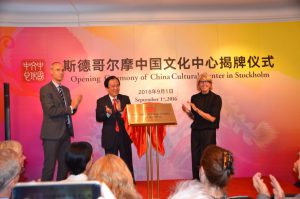
陈育明大使和瑞典国务秘书奥斯卡.斯坦斯特伦,瑞典学会会长安妮卡.兰贝为文化中心揭牌。陈雪霏拍摄
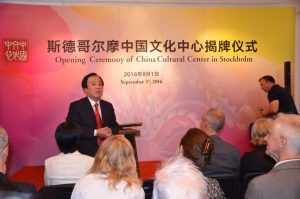 陈大使在致开幕词时说,文化是沟通人与人心灵和情感的桥梁,是国与国加深了解和信任的纽带。海外中国文化中心围绕“文化交流、教学培训、思想对话、信息服务”四大职能,开展多种形式的文化交流活动,是全面介绍中华文化的窗口、深入开展文化合作的平台、增进理解互信的桥梁。作为常态化双边文化交流的崭新平台,它将成为中瑞关系深入发展的见证人。
陈大使在致开幕词时说,文化是沟通人与人心灵和情感的桥梁,是国与国加深了解和信任的纽带。海外中国文化中心围绕“文化交流、教学培训、思想对话、信息服务”四大职能,开展多种形式的文化交流活动,是全面介绍中华文化的窗口、深入开展文化合作的平台、增进理解互信的桥梁。作为常态化双边文化交流的崭新平台,它将成为中瑞关系深入发展的见证人。
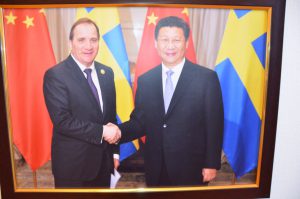 他还说,为庆祝中心成立,特意举办了顶尖水平的中国意象油画作品展和回顾中瑞建交66年来的交往史篇。今后,向公众开放的中国文化中心将陆续推出中国艺术展览、音乐会、演出和学术讲座,以及图书馆和汉语课堂。
他还说,为庆祝中心成立,特意举办了顶尖水平的中国意象油画作品展和回顾中瑞建交66年来的交往史篇。今后,向公众开放的中国文化中心将陆续推出中国艺术展览、音乐会、演出和学术讲座,以及图书馆和汉语课堂。
他欢迎各界朋友经常过来作客,欣赏艺术家的作品,观看文艺表演,参加艺术沙龙或是学习中文,品尝香茗。
斯德哥尔摩中国文化中心主任浦正东在接受记者采访时说,这是全球第27个中国文化中心,致力于与当地文化的结合,产生一些共鸣,将来能够深入化,本土化,地方化,就是能和等地的文化结合合作,然后,把两国的交流推向深入。
出席揭牌仪式的有华人华侨侨领和代表,来自50多个国家的驻瑞典使节,瑞典文化部和中国文化部的领导等近200人。
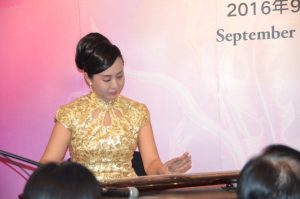 揭牌后,人们欣赏了特地赶来为大家演出的中国著名古琴表演艺术家邓红演奏的古典曲目《高山流水》。陈雪霏拍摄
揭牌后,人们欣赏了特地赶来为大家演出的中国著名古琴表演艺术家邓红演奏的古典曲目《高山流水》。陈雪霏拍摄
邓红和龙莲合奏琴箫。 陈雪霏拍摄
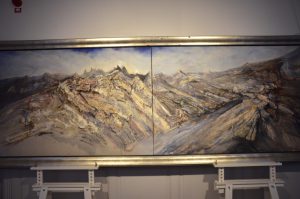 文化中心开幕之时也是中国意象派油画展开展之时。人们在艺术家的带领下参观了油画展。
文化中心开幕之时也是中国意象派油画展开展之时。人们在艺术家的带领下参观了油画展。
前国家主席胡锦涛于2007年6月9日访问瑞典。瑞典国王卡尔十六世古斯塔夫陪同检阅皇家卫队。 陈雪霏翻拍。
中心还展出了标志两国交往历史的图片。其中令人印象深刻的是还有一张毛泽东主席接见瑞典友人的珍贵照片。众所周知,瑞典是与中国建交的第一个西方国家。
瑞典国务秘书奥斯卡.斯坦斯特伦致开幕词。 陈雪霏拍摄
瑞典文化部国际司司长托马斯.林德曼在接受记者采访时说,文化中心的揭牌背后是很长一段时间双方的共同努力,他一路见证了期间的工作。
他说,中瑞之间已经有很好的合作,他相信文化中心的建立会继续推动双方在开放对话的框架下很好地合作。
瑞典学会会长安妮卡.兰贝说,这是一个非常重要的事件。这为双方进行交流和富有成果对话提供了很好的平台,使双方能够分享我们不同的社会和文化。这是一座非常美丽的建筑,里边的意象派画展也非常美。所以,她非常期待中心未来的各种活动。她说,现在无论是中国和瑞典还是其他国家,我们都面临各种挑战,因此,相互交流分享我们的观点,进行公开开放自由的对话非常重要。而文化中心可以成为对话交流很好的平台。
为庆祝这一双边交往的大喜事,陈育明大使和白晓梅参赞率领全馆同仁为大家举行了招待会。
据了解,意象派油画作品展和图片展将持续一个月的时间。

She was treated as a good example of translating scientific achievement into policies and applied in communities.
In its citation, The Stockholm Water Prize Nominating Committee said that “The nexus of water-related microbiology, water quality and public health is rife with uncertainty – in both theory and practice. The world is blessed with few individuals who can tackle the increasing and changing challenges to clean water and health, starting from state-of-the-art science through dedicated and original research, then moving to professional dissemination, effective lobbying of the legislative arena, influencing practitioners, and raising the general awareness. Joan Rose is the leading example of this extremely rare blend of talents.”
After she received the Prize, Professor Rose said she was honored.
“As an individual it is an honour and I am overflowing with gratitude. But it means even more, because it is a prize that honours water, it honours the blue planet and it honours the human condition. Therefore, I am very proud”.
Joan Rose is widely regarded as the world’s foremost authority on the microorganism Cryptosporidium. In 1993, the largest outbreak to date of the intestinal parasite Cryptosporidium affected more than 400 000 people in Milwaukee, US, who got sick from contaminated drinking water. 69 people died in the outbreak. Cryptosporidium, which exists in both humans and animals, cannot be killed by chlorine, and lives for several months.
Professor Rose and her team, whom she calls “water detectives” investigate waterborne disease outbreaks globally, to determine how they can be stopped, and prevented. She was the first person to present the widespread occurrence ofCryptosporidium in water supplies in 1988.
“More than two billion people still lack adequate sanitation, and over one billion lack access to safe drinking water. Hundreds of thousands of deaths from diarrhoeal diseases each year could be prevented by improved water, sanitation and hygiene. Joan Rose, our water hero, is a beacon of light in the quest for securing a better, healthier life for this and future generations,” commented SIWI’s Executive Director Torgny Holmgren.
Talking about what she believes is the world’s greatest water challenge, Professor Rose said: “I think it is going to be the reversal of water quality problems around the world; the algal blooms in fresh water and coastal waters, and the pollution, not just associated with humans, but also with disease outbreaks among our wildlife, like amphibians and fish. I also think reconnecting water and food security will be a major challenge. We are starting to do it but it will definitely continue to be a challenge.”
Professor Rose was key in establishing the 2004 WHO Drinking Water Standard, setting out a new WHO paradigm with direct impact on virtually all countries; Rose also worked in Malawi and Kenya to help translate these into local regulation. UNESCO’s International Hydrological Program asked for her leadership in meeting its goals of resource management and capacity building for Member States. She chaired a specialist group within the International Water Association to ensure understanding and incorporation of updated standards at the state and national level in engineer standards around the world. Her expertise in identifying and prioritizing issues of water quality led to codification of the Great Lakes Water Quality agreement. She Chairs Singapore’s Water Audit Panel of the influential Public Utilities Board; Canada and Korea sought her guidance. And to use today’s technology, she established an online collective of 140 scientists in the Global Water Pathogens Project.
The Stockholm Water Prize is a global award founded in 1991 and presented annually by Stockholm International Water Institute (SIWI) to an individual, organization or institution for outstanding water-related achievements. H.M. King Carl XVI Gustaf of Sweden is patron of the prize. The Stockholm Water Prize Founders, united in their strong conviction to drive sustainability in the water sector, are: Bacardi, Borealis & Borouge, Europeiska ERV, HP, Kemira, Poul Due Jensen Foundation, Ragn-Sells, Scandinavian Airlines (SAS), Snecma/Safran, Water Environment Federation (WEF), Xylem and Ålandsbanken.